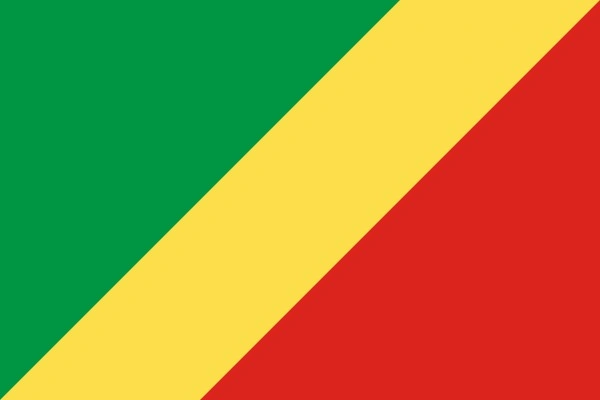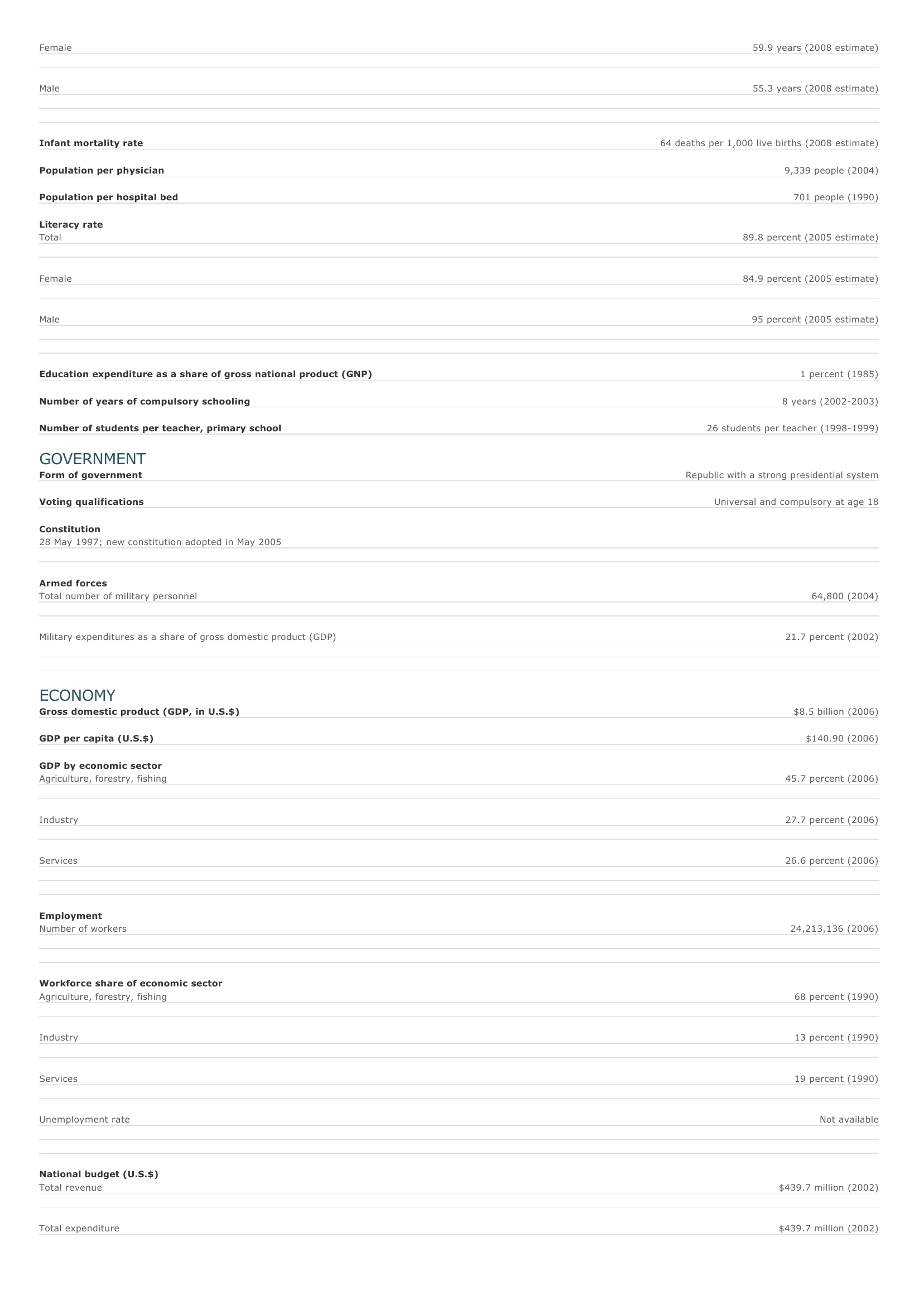
Democratic Republic of the Congo Facts and Figures. BASIC FACTS Official name Capital Area Democratic Republic of the Congo (DRC) Kinshasa 2,344,885 sq km 905,365 sq mi PEOPLE Population 68,008,922 (2008 estimate) Population growth Population growth rate 3.36 percent (2008 estimate) Projected population in 2025 114,263,739 (2025 estimate) Projected population in 2050 203,039,557 (2050 estimate) Population density 30 persons per sq km (2008 estimate) 78 persons per sq mi (2008 estimate) Urban/rural distribution Share urban 33 percent (2005 estimate) Share rural 67 percent (2005 estimate) Largest cities, with population Kinshasa 5,277,000 (2003 estimate) Lubumbashi 1,140,000 (2007 estimate) Kisangani 417,517 (1994 estimate) Ethnic groups There are more than 200 African ethnic groups. The largest culture groups are the Lunda, Luba, Kuba, Bakongo (Kongo), Mongo, Mangbetu, and Azande. Other Bantu, Nilo-Saharan, African-Asian, European, and Asian groups also exist. Languages French (official), Lingala, Kikongo, Tshiluba, Swahili, other indigenous languages Religious affiliations Christian 95 percent Roman Catholic 52 percent Protestant 20 percent Other Christian 23 percent Muslim 2 percent Indigenous beliefs 2 percent O ther 1 percent HEALTH AND EDUCATION Life expectancy Total 57.6 years (2008 estimate) Female 59.9 years (2008 estimate) Male 55.3 years (2008 estimate) Infant mortality rate Population per physician Population per hospital bed 64 deaths per 1,000 live births (2008 estimate) 9,339 people (2004) 701 people (1990) Literacy rate Total 89.8 percent (2005 estimate) Female 84.9 percent (2005 estimate) Male Education expenditure as a share of gross national product (GNP) Number of years of compulsory schooling Number of students per teacher, primary school 95 percent (2005 estimate) 1 percent (1985) 8 years (2002-2003) 26 students per teacher (1998-1999) GOVERNMENT Form of government Republic with a strong presidential system Voting qualifications Universal and compulsory at age 18 Constitution 28 May 1997; new constitution adopted in May 2005 Armed forces Total number of military personnel Military expenditures as a share of gross domestic product (GDP) 64,800 (2004) 21.7 percent (2002) ECONOMY Gross domestic product (GDP, in U.S.$) GDP per capita (U.S.$) $8.5 billion (2006) $140.90 (2006) GDP by economic sector Agriculture, forestry, fishing 45.7 percent (2006) I ndustry 27.7 percent (2006) Services 26.6 percent (2006) Employment Number of workers 24,213,136 (2006) Workforce share of economic sector Agriculture, forestry, fishing 68 percent (1990) I ndustry 13 percent (1990) Services 19 percent (1990) Unemployment rate Not available National budget (U.S.$) Total revenue $439.7 million (2002) Total expenditure $439.7 million (2002) Monetary unit 1 Congolese franc, consisting of 100 centimes Major trade partners for exports Belgium, United States, Zimbabwe, Finland, and Italy Major trade partners for imports South Africa, Belgium, Nigeria, France, and Kenya ENERGY, COMMUNICATIONS, AND TRANSPORTATION Electricity production Electricity from thermal sources Electricity from hydroelectric sources 0.32 percent (2003 estimate) 99.68 percent (2003 estimate) Electricity from nuclear sources 0 percent (2003 estimate) Electricity from geothermal, solar, and wind sources 0 percent (2003 estimate) Number of radios per 1,000 people 376 (1997) Number of telephones per 1,000 people 0 (2005) Number of televisions per 1,000 people 2 (1998 estimate) Number of Internet hosts per 10,000 people Daily newspaper circulation per 1,000 people Number of motor vehicles per 1,000 people Paved road as a share of total roads 0.03 (2003) 3 (1996) 31 (1997) 2 percent (2004) SOURCES Basic Facts and People sections Area data are from the statistical bureaus of individual countries. Population, population growth rate, and population projections are from the United States Census Bureau, International Programs Center, International Data Base (IDB) (www.census.gov). Urban and rural population data are from the Food and Agriculture Organization (FAO) of the United Nations (UN), FAOSTAT database (www.fao.org). Largest cities population data and political divisions data are from the statistical bureaus of individual countries. Ethnic divisions and religion data are largely from the latest Central Intelligence Agency (CIA) World Factbook and from various country censuses and reports. Language data are largely from the Ethnologue, Languages of the World, Summer Institute of Linguistics International (www.sil.org). Health and Education section Life expectancy and infant mortality data are from the United States Census Bureau, International Programs Center, International database (IDB) (www.census.gov). Population per physician and population per hospital bed data are from the World Health Organization (WHO) (www.who.int). Education data are from the United Nations Educational, Scientific and Cultural Organization (UNESCO) database (www.unesco.org). Government section Government, independence, legislature, constitution, highest court, and voting qualifications data are largely from various government Web sites, the latest Europa World Yearbook, and the latest Central Intelligence Agency (CIA) World Factbook. The armed forces data is from Military Balance. Economy section Gross domestic product (GDP), GDP per capita, GDP by economic sectors, employment, and national budget data are from the World Bank database (www.worldbank.org). Monetary unit, agriculture, mining, manufacturing, exports, imports, and major trade partner information is from the statistical bureaus of individual countries, latest Europa World Yearbook, and various United Nations and International Monetary Fund (IMF) publications. Energy, Communication, and Transportation section Electricity information is from the Energy Information Administration (EIA) database (www.eia.doe.gov). Radio, telephone, television, and newspaper information is from the United Nations Educational, Scientific and Cultural Organization (UNESCO) database (www.unesco.org). Internet hosts, motor vehicles, and road data are from the World Bank database (www.worldbank.org). Note Figures may not total 100 percent due to rounding. Microsoft ® Encarta ® 2009. © 1993-2008 Microsoft Corporation. All rights reserved.











